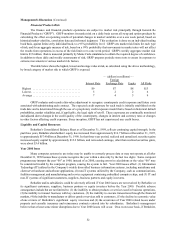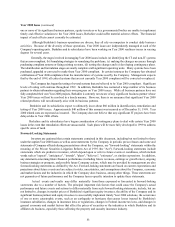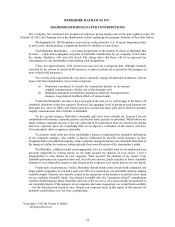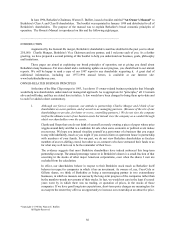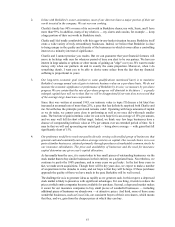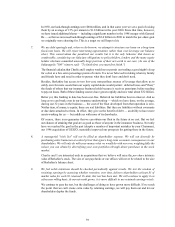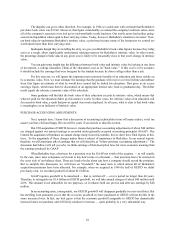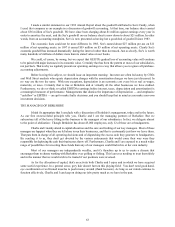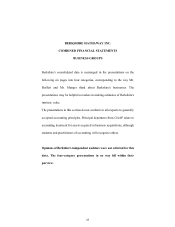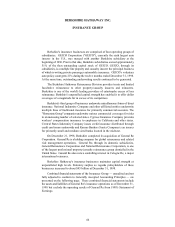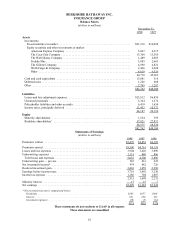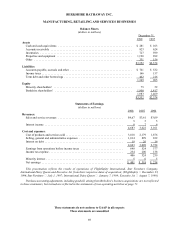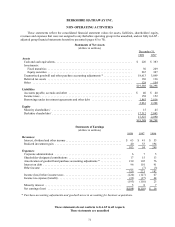Berkshire Hathaway 1998 Annual Report Download - page 62
Download and view the complete annual report
Please find page 62 of the 1998 Berkshire Hathaway annual report below. You can navigate through the pages in the report by either clicking on the pages listed below, or by using the keyword search tool below to find specific information within the annual report.61
In all of our communications, we try to make sure that no single shareholder gets an edge: We do
not follow the usual practice of giving earnings "guidance" or other information of value to analysts
or large shareholders. Our goal is to have all of our owners updated at the same time.
13. Despite our policy of candor, we will discuss our activities in marketable securities only to the
extent legally required. Good investment ideas are rare, valuable and subject to competitive
appropriation just as good product or business acquisition ideas are. Therefore we normally will
not talk about our investment ideas. This ban extends even to securities we have sold (because we
may purchase them again) and to stocks we are incorrectly rumored to be buying. If we deny those
reports but say "no comment" on other occasions, the no-comments become confirmation.
Though we continue to be unwilling to talk about specific stocks, we freely discuss our business and
investment philosophy. I benefitted enormously from the intellectual generosity of Ben Graham, the
greatest teacher in the history of finance, and I believe it appropriate to pass along what I learned
from him, even if that creates new and able investment competitors for Berkshire just as Ben's
teachings did for him.
AN ADDED PRINCIPLE
To the extent possible, we would like each Berkshire shareholder to record a gain or loss in market
value during his period of ownership that is proportional to the gain or loss in per-share intrinsic
value recorded by the company during that holding period. For this to come about, the relationship
between the intrinsic value and the market price of a Berkshire share would need to remain
constant, and by our preferences at 1-to-1. As that implies, we would rather see Berkshire's stock
price at a fair level than a high level. Obviously, Charlie and I can't control Berkshire's price. But
by our policies and communications, we can encourage informed, rational behavior by owners that,
in turn, will tend to produce a stock price that is also rational. Our it's-as-bad-to-be-overvalued-as-
to-be-undervalued approach may disappoint some shareholders. We believe, however, that it affords
Berkshire the best prospect of attracting long-term investors who seek to profit from the progress
of the company rather than from the investment mistakes of their partners.
INTRINSIC VALUE
Now let's focus on two terms that I mentioned earlier and that you will encounter in future annual reports.
Let's start with intrinsic value, an all-important concept that offers the only logical approach to evaluating
the relative attractiveness of investments and businesses. Intrinsic value can be defined simply: It is the discounted
value of the cash that can be taken out of a business during its remaining life.
The calculation of intrinsic value, though, is not so simple. As our definition suggests, intrinsic value is an
estimate rather than a precise figure, and it is additionally an estimate that must be changed if interest rates move or
forecasts of future cash flows are revised. Two people looking at the same set of facts, moreover — and this would
apply even to Charlie and me — will almost inevitably come up with at least slightly different intrinsic value figures.
That is one reason we never give you our estimates of intrinsic value. What our annual reports do supply, though, are
the facts that we ourselves use to calculate this value.
Meanwhile, we regularly report our per-share book value, an easily calculable number, though one of limited
use. The limitations do not arise from our holdings of marketable securities, which are carried on our books at their
current prices. Rather the inadequacies of book value have to do with the companies we control, whose values as
stated on our books may be far different from their intrinsic values.



